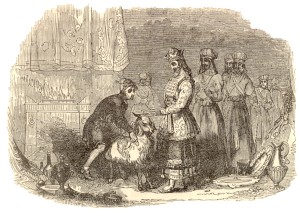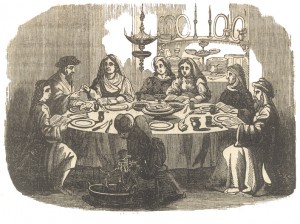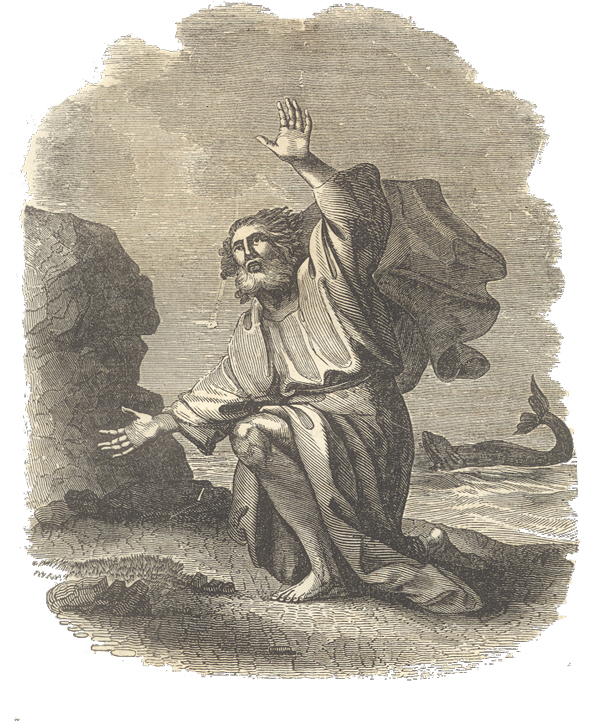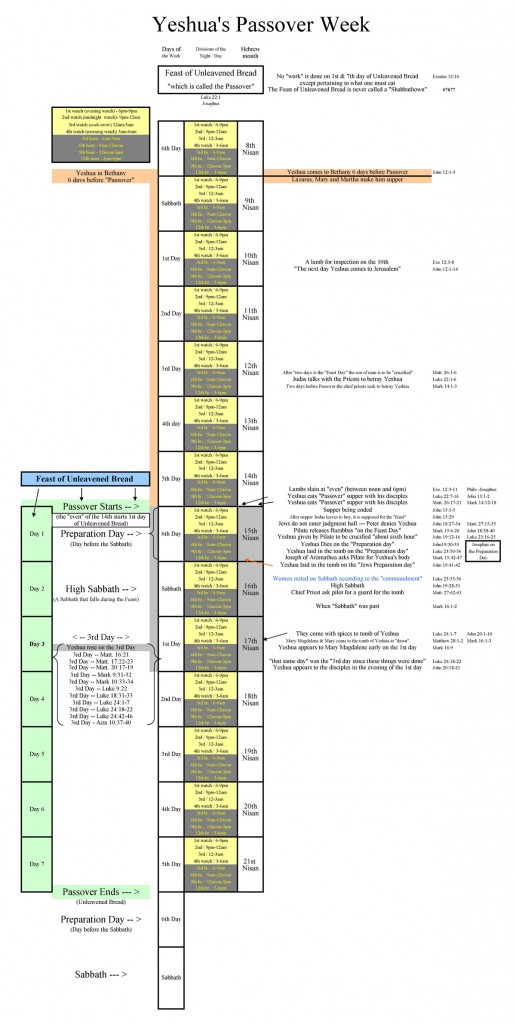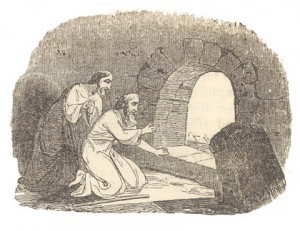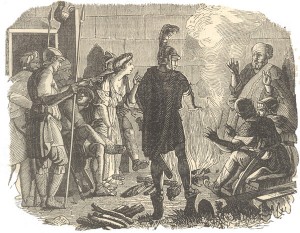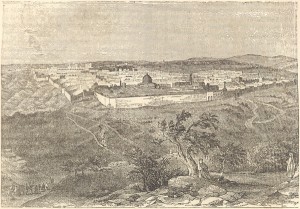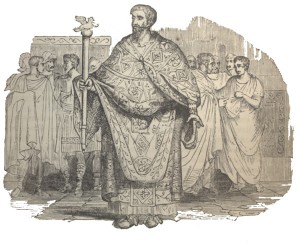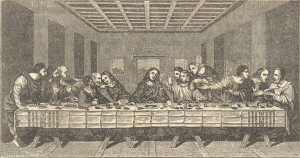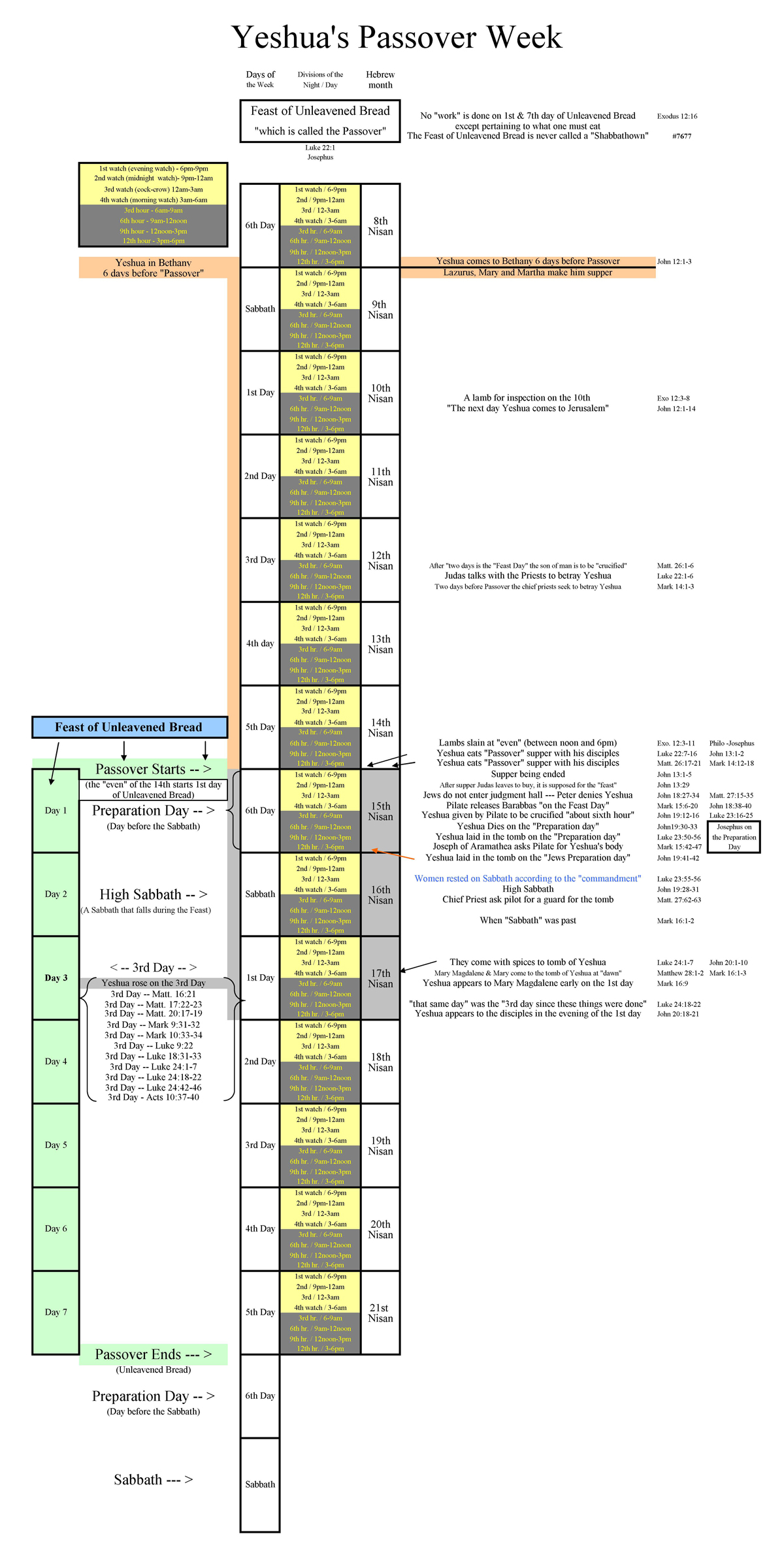Authors Note:
Based upon the Bible’s calendar today is the 14th day of the 1st month. Nearly 2000 years ago about this time Yeshua of Nazareth became “the lamb of God which taketh away the sins of the world”. Later today many of us will celebrate Passover in rememberance of Yeshua’s sacrifice on our behalf. With this in mind I thought it appropriate to share some little known symbolism associated with this wonderfully symbolic Biblical holyday. The following is taken from my book The 13th Enumeration: Key to the Bible’s Messianic symbolism.
The 14th Sacrifice
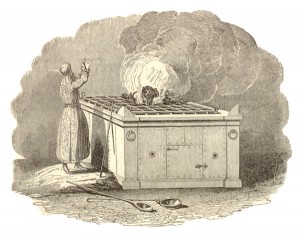 Yet it pleased YHWH to bruise him; he hath put him to grief: when thou shalt make his soul an offering for sin, he shall see his seed, he shall prolong his days, and the pleasure of YHWH shall prosper in his hand. He shall see of the travail of his soul, and shall be satisfied: by his knowledge shall my righteous servant justify many; for he shall bear their iniquities. Therefore will I divide him a portion with the great, and he shall divide the spoil with the strong; because he hath poured out his soul unto death: and he was numbered with the transgressors; and he bare the sin of many, and made intercession for the transgressors.—Isaiah 53:10–12
Yet it pleased YHWH to bruise him; he hath put him to grief: when thou shalt make his soul an offering for sin, he shall see his seed, he shall prolong his days, and the pleasure of YHWH shall prosper in his hand. He shall see of the travail of his soul, and shall be satisfied: by his knowledge shall my righteous servant justify many; for he shall bear their iniquities. Therefore will I divide him a portion with the great, and he shall divide the spoil with the strong; because he hath poured out his soul unto death: and he was numbered with the transgressors; and he bare the sin of many, and made intercession for the transgressors.—Isaiah 53:10–12
I’m continually thrilled by the Messianic symbolism YHWH has hidden in the Scripture for us to find. To me, it’s the ultimate treasure hunt, with each new find bringing additional depth and beauty to our Creator’s plan of reconciliation for all mankind through Yeshua.
Purge out therefore the old leaven, that ye may be a new lump, as ye are unleavened. For even Christ our passover is sacrificed for us: therefore let us keep the feast, not with old leaven, neither with the leaven of malice and wickedness; but with the unleavened bread of sincerity and truth. (1 Corinthians 5:7–8)
It was therefore necessary that the patterns of things in the heavens should be purified with these; but the heavenly things themselves with better sacrifices than these . . . So Christ was once offered to bear the sins of many; and unto them that look for him shall he appear the second time without sin unto salvation. (Hebrews 9:23–28)
For the law having a shadow of good things to come, and not the very image of the things, can never with those sacrifices which they offered year by year continually make the comers thereunto perfect . . . we are sanctified through the offering of the body of Jesus Christ once for all. (Hebrews 10:1–10)
A Wonderful Puzzle
Right up front, I’ll admit my bias: I believe the Bible to be the inspired words of YHWH. When there are passages that don’t make any sense or seem downright funky—passages like Matthew 1—I like to look at these parts as a wonderful puzzle to solve.
Another good example of what I’m talking about is the order and number of sacrifices prescribed during the biblical feast days. I mean, have you ever looked at the numbers of the sacrifices YHWH commanded Israel to offer? For instance, why were two bullocks, one ram, and seven lambs required to be offered during the Feast of Unleavened Bread? Doesn’t that seem just a little unusual to you? Their number and order are obviously specific—but why?
For those who have looked, you would have to say it is almost like a code. If there is a symbolic or coded message in the number of sacrifices prescribed in the Old Testament, could it somehow be related to the Messianic symbolism we have already found in the biblical holy days—or to Matthew 1? What are the chances the 13th Enumeration could be the key? Let’s take a look and see.
What better place to start than the book of the Bible the Jewish people call Bemidbar, “in the desert”—probably better known to you and me as the book of Numbers. The fourth book of the Bible, Numbers gives more details about the biblical sacrifices prescribed during the feast days than any other place in the Scriptures.
The first biblical feast day begins in the spring, with Passover, on the 14th day of the first month at “even.” In biblical timekeeping, evening, or sundown, begins the day. In this case, the evening of the 14th is the start of the 15th day of Nisan. Fourteen days earlier, the Torah honors the start of the biblical calendar with the following instructions:
And in the beginnings of your months ye shall offer a burnt offering unto YHWH; two young bullocks, and one ram, seven lambs of the first year without spot . . . and one kid of the goats for a sin offering unto YHWH shall be offered, beside the continual burnt offering, and his drink offering. (Numbers 28:11–15)
You know, I still ask myself how I missed it all these years:
2 bullocks (burnt offering)
1 ram (burnt offering)
7 lambs (burnt offering)
1 kid of the goats (sin offering)
2 lambs (continual burnt offering)
13 total sacrifices
Right there in the book of Numbers, the biblical calendar begins with 13 sacrifices. How awesome is that!
And walk in love, as Christ also hath loved us, and hath given himself for us an offering and a sacrifice to God for a sweetsmelling savour. (Ephesians 5:2)
But the symbolism doesn’t stop there. Numbers 28 and 29 go on to prescribe 13 sacrifices each day for the entire Feast of Unleavened Bread, as well as during Shavuot, Yom Kippur, and the 8th day of Tabernacles.[1] As we will see in the next chapter, the sacrificial instructions for the first seven days of the Feast of Tabernacles (Sukkoth) are nothing short of amazing!
But before we get to that, there is a hidden treasure yet to be discovered in the Feast of Unleavened Bread. Unleavened Bread is a feast of seven days which began with the Passover supper. In order to see the wonderful symbolism here, a little history of Israel’s exodus from Egypt is required.
Few Old Testament stories capture our imaginations like the exodus of Israel from Egypt. From Moses’s confrontation with Pharaoh to the plagues, the angel of death, and finally the crossing of the Red Sea, the imagery is captivating, sobering, and finally triumphant. The events described in the book of Exodus set a pattern or shadow, if you will, which the New Testament sees fulfilled in the death and resurrection of Yeshua.
Most of us know the story of the Passover. Every Israelite household was instructed to kill a lamb and mark the doorposts with its blood. This sacrifice is described in the Bible as “YHWH’s Passover.” The angel of death would “pass over” any house upon which this blood was found, thus sparing the inhabitants the death of their firstborn in Egypt’s most terrible plague.
The order and timing of these events are fascinating, not the least because they mark the Passover with the symbolism of the numbers 13 and 14. Let’s take a look:
And they departed from Rameses in the first month, on the fifteenth day of the first month; on the morrow after the passover the children of Israel went out with an high hand in the sight of all the Egyptians. For the Egyptians buried all their firstborn, which YHWH had smitten among them: upon their gods also YHWH executed judgments. (Numbers 33:3 4)
The above passage gives us an excellent fixing point in the chronology of the exodus. Verse 3 makes it clear that the exodus from Egypt began on the 15th day of the first month. Further, it informs us that this same day, the Egyptians were busy burying their firstborn dead. Exodus 12 fixes the chronology even further with the instructions concerning the Passover lamb. They were to keep this lamb until the 14th day, kill it in the evening (sundown) of the 14th day, and then eat it that night, which began the 15th of Nisan—the same night the angel of death passed over Egypt.
Your lamb shall be without blemish, a male of the first year . . . And ye shall keep it up until the fourteenth day of the same month: and the whole assembly of the congregation of Israel shall kill it in the evening. And they shall take of the blood, and strike it on the two side posts and on the upper door post of the houses, wherein they shall eat it. And they shall eat the flesh in that night, roast with fire, and unleavened bread; and with bitter herbs they shall eat it. Eat not of it raw, nor sodden at all with water, but roast with fire; his head with his legs, and with the purtenance thereof . . . And ye shall let nothing of it remain until the morning; and that which remaineth of it until the morning ye shall burn with fire.
And thus shall ye eat it; with your loins girded, your shoes on your feet, and your staff in your hand; and ye shall eat it in haste: it is YHWH’S passover. For I will pass through the land of Egypt this night, and will smite all the firstborn in the land of Egypt, both man and beast; and against all the gods of Egypt I will execute judgment: I am YHWH. (Exodus 12:5–12)
And it came to pass, that at midnight YHWH smote all the firstborn in the land of Egypt . . . And Pharaoh rose up in the night, he, and all his servants, and all the Egyptians; and there was a great cry in Egypt; for there was not a house where there was not one dead. And he called for Moses and Aaron by night, and said, Rise up, and get you forth from among my people . . . And the Egyptians were urgent upon the people, that they might send them out of the land in haste; for they said, We be all dead men. (Exodus 12:29–33)
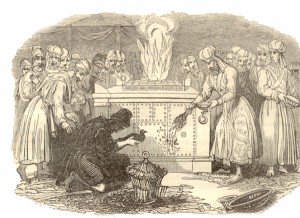 Based upon the above chronology, the Passover lambs were killed on the 14th of Nisan just before or right at sundown, which began the 15th day of the month. This passage makes it clear that the sacrifice was not eaten until that “night,” the very same night the angel of death “passed over” the land of Egypt. Remember, a new biblical day begins at sundown.
Based upon the above chronology, the Passover lambs were killed on the 14th of Nisan just before or right at sundown, which began the 15th day of the month. This passage makes it clear that the sacrifice was not eaten until that “night,” the very same night the angel of death “passed over” the land of Egypt. Remember, a new biblical day begins at sundown.
And God called the light Day, and the darkness he called Night. And the evening and the morning were the first day. (Genesis 1:5)
Now consider once again the instructions of Numbers 28 in light of this chronology. Numbers 28 requires 13 sacrifices to be made on the 15th of Nisan, the first day of the Feast of Unleavened Bread. But there is a 14th sacrifice as well. The Passover lamb, killed on the 14th, was to be eaten “in that night,” which began the 15th of Nisan. So in fitting symbolism, just as Matthew 1 showed Yeshua as both the 13th and 14th Enumerations, the first day of the Feast of Unleavened Bread, the very biblical holyday which represents Yeshua’s atonement on our behalf, requires 13 sacrifices to be made, but in fact 14 are consumed! This brings new meaning to the words of Paul in his epistle to the Corinthians:
Purge out therefore the old leaven, that ye may be a new lump, as ye are unleavened. For even Christ our passover is sacrificed for us. (1 Corinthians 5:7)
For more on Yeshua’s Passover Week chronology please see the following articles:
* The 14th Sacrifice
* “The Feast Day”: Judas’ Betrayal
* Defiled on the “Passover”
* The “Preparation” Day
* The “3rd Day”
* “The Sign of Jonah
And thou shalt say unto them, This is the offering made by fire which ye shall offer unto YHWH; two lambs of the first year without spot day by day, for a continual burnt offering. —Numbers 28:3–4
“and in the fourteenth day of the first month is the passover of YHWH. And in the fifteenth day of this month is the feast: seven days shall unleavened bread be eaten . . . But ye shall offer a sacrifice made by fire for a burnt offering unto YHWH; two young bullocks, and one ram, and seven lambs of the first year . . . and one goat for a sin offering, to make an atonement for you. Ye shall offer these beside the burnt offering in the morning, which is for a continual burnt offering. After this manner ye shall offer daily, throughout the seven days, the meat of the sacrifice made by fire, of a sweet savour unto YHWH: it shall be offered beside the continual burnt offering, and his drink offering. —Numbers 28:16–24
Also in the day of the firstfruits . . . But ye shall offer the burnt offering for a sweet savour unto YHWH; two young bullocks, one ram, seven lambs of the first year . . . and one kid of the goats, to make an atonement for you. Ye shall offer them beside the continual burnt offering, and his meat offering, (they shall be unto you without blemish) and their drink offerings. —Numbers 28:26–31
[1] The Feast of Trumpets, according to Numbers 29, also requires 13 sacrifices, but if the new-moon sacrifices of the first month are included, they make for 24. Leviticus 23 includes two peace offerings for the feast of Shavuot that are not included in the sacrifices of Numbers 28. This would make for 15 if both instructions were combined. It is also important to note that any day that fell on a Sabbath required two additional sacrifices.

